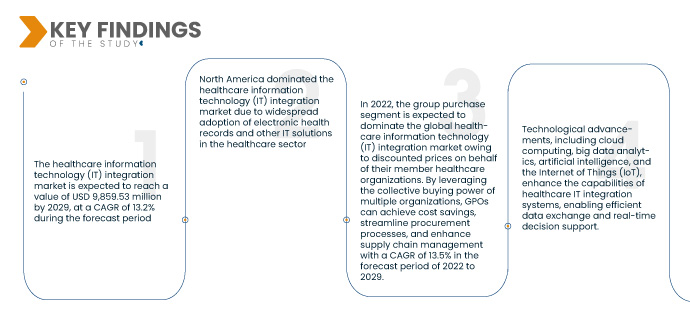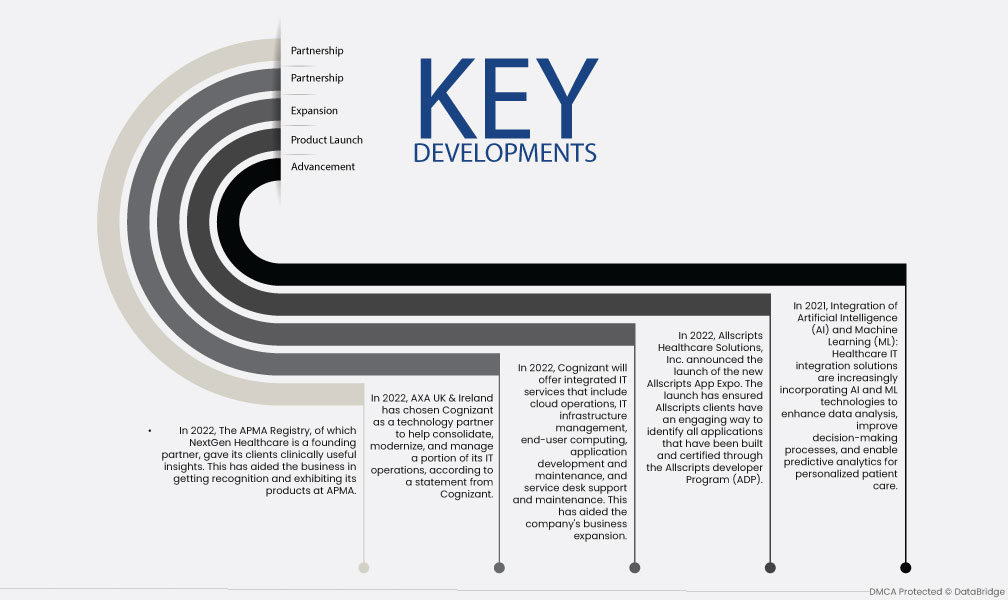Gesundheitssysteme können Daten erfassen, mit der Cloud austauschen und durch die Integration von Gesundheits-IT miteinander kommunizieren. Dies ermöglicht eine schnelle und präzise Datenanalyse. Überwachung, Diagnose und Bereitstellungsmethoden sind nur einige der Aufgaben, die das Internet der Dinge (IoT) durch die Kombination von Sensordaten und Kommunikation übernehmen kann. Die Sensoren können in Maschinen integriert, über die Cloud zugänglich oder tragbar sein. Dank der Fortschritte in der IKT und der Entwicklung solcher Sensoren hat das Gesundheitswesen nun Zugriff auf eine dynamische Datenbank mit Patientendaten. Diese kann zur Unterstützung der Diagnostik, zur Bereitstellung präventiver Maßnahmen und zur Bestimmung der Erfolgswahrscheinlichkeit einer präventiven Behandlung genutzt werden.
Vollständigen Bericht abrufen unter https://www.databridgemarketresearch.com/reports/global-healthcare-it-integration-market
Data Bridge Market Research prognostiziert, dass der Markt für die Integration von Gesundheitsinformationstechnologie (IT) bis 2029 voraussichtlich einen Wert von 9.859,53 Millionen US-Dollar erreichen wird, was einer durchschnittlichen jährlichen Wachstumsrate (CAGR) von 13,2 % im Prognosezeitraum entspricht. Die Integration von Gesundheitsinformationstechnologie (IT) ermöglicht den nahtlosen Austausch von Patienteninformationen zwischen verschiedenen Gesundheitssystemen und -anbietern und ermöglicht so eine verbesserte Koordination der Versorgung, Entscheidungsfindung und bessere Patientenergebnisse. Dies treibt den Markt für die Integration von Gesundheitsinformationstechnologie (IT) voran.
Der Fokus auf Kostensenkung und Effizienz dürfte das Marktwachstum ankurbeln
Gesundheitsorganisationen erkennen die Bedeutung von Kostensenkung und betrieblicher Effizienz für eine qualitativ hochwertige Versorgung. Die Implementierung von IT-Integrationslösungen kann verschiedene Prozesse wie Patientendatenverwaltung, Terminplanung, Abrechnung und Ressourcenzuweisung optimieren. Diese Lösungen ermöglichen den nahtlosen Informationsaustausch zwischen verschiedenen Gesundheitssystemen und -abteilungen, reduzieren Redundanzen und steigern die Produktivität. Dies führt letztendlich zu Kosteneinsparungen, einer verbesserten Ressourcennutzung und einer verbesserten Patientenversorgung.
Berichtsumfang und Marktsegmentierung
Berichtsmetrik
|
Details
|
Prognosezeitraum
|
2022 bis 2029
|
Basisjahr
|
2021
|
Historische Jahre
|
2020 (Anpassbar auf 2014–2019)
|
Quantitative Einheiten
|
Umsatz in Millionen USD, Mengen in Einheiten, Preise in USD
|
Abgedeckte Segmente
|
Produkte und Dienstleistungen (Produkt und Dienstleistungen), Anwendung (Integration medizinischer Geräte, interne Integration, Krankenhausintegration, Laborintegration, Klinikintegration und Radiologieintegration), Einrichtungsgröße (groß, mittel und klein), Kaufmodus (Gruppenkauforganisation und Einzelperson), Endbenutzer (Krankenhäuser, Labore, Diagnosezentren, Radiologiezentren und Kliniken).
|
Abgedeckte Länder
|
USA, Kanada und Mexiko in Nordamerika, Deutschland, Frankreich, Großbritannien, Niederlande, Schweiz, Belgien, Russland, Italien, Spanien, Türkei, Restliches Europa in Europa, China, Japan, Indien, Südkorea, Singapur, Malaysia, Australien, Thailand, Indonesien, Philippinen, Restlicher Asien-Pazifik-Raum (APAC) im Asien-Pazifik-Raum (APAC), Saudi-Arabien, Vereinigte Arabische Emirate, Südafrika, Ägypten, Israel, Restlicher Naher Osten und Afrika (MEA) als Teil des Nahen Ostens und Afrikas (MEA), Brasilien, Argentinien und Restliches Südamerika als Teil von Südamerika.
|
Abgedeckte Marktteilnehmer
|
Lyniate (USA), Redox, Inc. (USA), CarePoint Health (USA), NextGen Healthcare Inc. (USA), Interfaceware, Inc. (Kanada), Koninklijke Philips (Niederlande), Oracle (USA), AVI-SPL, Inc. (USA), Allscripts Healthcare Solutions, Inc. (USA), Epic Systems Corporation (USA), Qualcomm Life Inc. (USA), Capsule Technologies Inc. (USA), Orion Health (Neuseeland), Quality Systems, Inc. (USA), Cerner Corporation (USA), InterSystems Corporation (USA), Infor Inc. (USA), GE Healthcare (USA), McKesson Corporation (USA) und Meditech (USA)
|
Im Bericht behandelte Datenpunkte
|
Zusätzlich zu den Einblicken in Marktszenarien wie Marktwert, Wachstumsrate, Segmentierung, geografische Abdeckung und wichtige Akteure umfassen die von Data Bridge Market Research kuratierten Marktberichte auch ausführliche Expertenanalysen, Patientenepidemiologie, Pipeline-Analysen, Preisanalysen und regulatorische Rahmenbedingungen.
|
Segmentanalyse:
Der Markt für die Integration von Informationstechnologie (IT) im Gesundheitswesen ist nach Produkten und Dienstleistungen, Anwendung, Einrichtungsgröße, Kaufmodus und Endbenutzer segmentiert.
- Der globale Markt für die Integration von Gesundheitsinformationstechnologie (IT) ist nach Produkten und Dienstleistungen segmentiert. Aufgrund der weltweit steigenden Nachfrage nach IT-Lösungen und -Dienstleistungen wird erwartet, dass das Dienstleistungssegment im Jahr 2022 den globalen Markt für die Integration von Gesundheitsinformationstechnologie (IT) mit einer durchschnittlichen jährlichen Wachstumsrate (CAGR) von 12,0 % im Prognosezeitraum von 2022 bis 2029 dominieren wird.
Im Jahr 2022 wird das Dienstleistungssegment voraussichtlich das Produkt- und Dienstleistungssegment des globalen Marktes für die Integration von Informationstechnologie (IT) im Gesundheitswesen dominieren
Im Jahr 2022 wird das Dienstleistungssegment voraussichtlich den globalen Markt für die Integration von Informationstechnologie (IT) im Gesundheitswesen dominieren, da es eine entscheidende Rolle bei der Unterstützung der Implementierung, Nutzung und Optimierung von Produkten und Technologien im Gesundheitswesen spielt, mit einer durchschnittlichen jährlichen Wachstumsrate (CAGR) von 12,0 % im Prognosezeitraum von 2022 bis 2029.
- Der globale Markt für die Integration von Gesundheitsinformationstechnologie (IT) ist nach Anwendung segmentiert in die Integration medizinischer Geräte, die interne Integration, die Krankenhausintegration, die Laborintegration, die Klinikintegration, die Radiologieintegration und weitere Anwendungen. Aufgrund der steigenden Nachfrage nach Telemedizindiensten und Lösungen zur Patientenfernüberwachung wird das Segment der Integration medizinischer Geräte im Prognosezeitraum 2022 bis 2029 voraussichtlich den globalen Markt für die Integration von Gesundheitsinformationstechnologie (IT) mit einer durchschnittlichen jährlichen Wachstumsrate (CAGR) von 14,9 % dominieren.
- Der globale Markt für die Integration von Gesundheitsinformationstechnologie (IT) wird anhand der Anlagengröße in große, mittlere und kleine Anlagen unterteilt. Im Jahr 2022 wird das große Segment voraussichtlich den globalen Markt für die Integration von Gesundheitsinformationstechnologie (IT) mit einer durchschnittlichen jährlichen Wachstumsrate (CAGR) von 14,5 % im Prognosezeitraum von 2022 bis 2029 dominieren, da es über eine große Fläche und die Kapazität verfügt, eine beträchtliche Anzahl von Personen oder Betrieben unterzubringen. Zu diesen Anlagen können große Produktionsstätten, Lagerhallen, Unternehmenszentralen, Einkaufszentren, Kongresszentren oder Krankenhäuser mit einer hohen Anzahl an Betten und Abteilungen gehören.
- Der globale Markt für die Integration von Gesundheitsinformationstechnologie (IT) wird nach Einkaufsmodus in Gruppeneinkäufe und Einzelkäufe segmentiert. Im Jahr 2022 wird das Segment Gruppeneinkäufe voraussichtlich den globalen Markt für die Integration von Gesundheitsinformationstechnologie (IT) mit einer durchschnittlichen jährlichen Wachstumsrate (CAGR) von 13,5 % im Prognosezeitraum von 2022 bis 2029 dominieren, da die gemeinsame Kaufkraft mehrerer Organisationen genutzt wird, um bessere Preise und Konditionen für Waren und Dienstleistungen zu erzielen.
Im Jahr 2022 wird das Segment der Gruppenkäufe voraussichtlich das Kaufmodussegment des globalen Marktes für die Integration von Informationstechnologie (IT) im Gesundheitswesen dominieren.
Im Jahr 2022 wird das Segment der Gruppeneinkäufe voraussichtlich den globalen Markt für die Integration von Informationstechnologie (IT) im Gesundheitswesen dominieren, da es den Mitgliedsorganisationen im Gesundheitswesen Preisnachlässe gewährt. Durch die Nutzung der gemeinsamen Kaufkraft mehrerer Organisationen können Gruppenunternehmen Kosteneinsparungen erzielen, Beschaffungsprozesse optimieren und das Lieferkettenmanagement verbessern – mit einer durchschnittlichen jährlichen Wachstumsrate (CAGR) von 13,5 % im Prognosezeitraum von 2022 bis 2029.
- Der globale Markt für die Integration von Gesundheitsinformationstechnologie (IT) ist nach Endnutzern in Krankenhäuser, Labore, Diagnosezentren, Radiologiezentren, Kliniken und andere segmentiert. Aufgrund der zunehmenden Anwendungsbereiche der Integration von Gesundheitsinformationstechnologie (IT) wird das Krankenhaussegment voraussichtlich im Jahr 2022 den globalen Markt für die Integration von Gesundheitsinformationstechnologie (IT) mit einer durchschnittlichen jährlichen Wachstumsrate (CAGR) von 14,6 % im Prognosezeitraum von 2022 bis 2029 dominieren.
Hauptakteure
Data Bridge Market Research erkennt die folgenden Unternehmen als die wichtigsten Akteure auf dem Markt für die Integration von Informationstechnologie (IT) im Gesundheitswesen an: Lyniate (USA), Redox, Inc. (USA), CarePoint Health (USA), NextGen Healthcare Inc. (USA), Interfaceware, Inc. (Kanada), Koninklijke Philips (Niederlande), Oracle (USA), AVI-SPL, Inc. (USA), Allscripts Healthcare Solutions, Inc. (USA), Epic Systems Corporation (USA)
Marktentwicklung
- Im Jahr 2022 lieferte das APMA-Register, dessen Gründungspartner NextGen Healthcare ist, seinen Kunden klinisch nützliche Einblicke. Dies hat dem Unternehmen geholfen, Anerkennung zu erlangen und seine Produkte auf der APMA auszustellen.
- Laut einer Erklärung von Cognizant hat sich AXA UK & Ireland im Jahr 2022 für Cognizant als Technologiepartner entschieden, um einen Teil seiner IT-Abläufe zu konsolidieren, zu modernisieren und zu verwalten.
- Ab 2022 wird Cognizant integrierte IT-Services anbieten, die Cloud-Betrieb, IT-Infrastrukturmanagement, End-User-Computing, Anwendungsentwicklung und -wartung sowie Service-Desk-Support und -Wartung umfassen. Dies hat die Geschäftsexpansion des Unternehmens unterstützt.
- Im Jahr 2022 kündigte Allscripts Healthcare Solutions, Inc. den Start der neuen Allscripts App Expo an. Durch die Einführung haben Allscripts-Kunden eine attraktive Möglichkeit, alle Anwendungen zu finden, die im Rahmen des Allscripts Developer Program (ADP) entwickelt und zertifiziert wurden.
- Im Jahr 2021: Integration von künstlicher Intelligenz (KI) und maschinellem Lernen (ML): IT-Integrationslösungen im Gesundheitswesen integrieren zunehmend KI- und ML-Technologien, um die Datenanalyse zu verbessern, Entscheidungsprozesse zu optimieren und prädiktive Analysen für eine personalisierte Patientenversorgung zu ermöglichen.
Regionale Analyse
Geografisch betrachtet sind die im Marktbericht zur Integration von Informationstechnologie (IT) im Gesundheitswesen abgedeckten Länder die USA, Kanada und Mexiko in Nordamerika, Deutschland, Frankreich, Großbritannien, die Niederlande, die Schweiz, Belgien, Russland, Italien, Spanien, die Türkei, das übrige Europa in Europa, China, Japan, Indien, Südkorea, Singapur, Malaysia, Australien, Thailand, Indonesien, die Philippinen, der übrige asiatisch-pazifische Raum (APAC) in der Region Asien-Pazifik (APAC), Saudi-Arabien, die Vereinigten Arabischen Emirate, Südafrika, Ägypten, Israel, der übrige Nahe Osten und Afrika (MEA) als Teil des Nahen Ostens und Afrikas (MEA), Brasilien, Argentinien und der übrige Südamerika als Teil von Südamerika.
Laut Marktforschungsanalyse von Data Bridge:
Nordamerika ist im Prognosezeitraum 2022–2029 die dominierende Region im Markt für die Integration von Informationstechnologie (IT) im Gesundheitswesen
Nordamerika ist ein dominierender Akteur auf dem globalen Markt für IT-Integration im Gesundheitswesen. Maßgeblich hierfür sind hohe Investitionen in Forschung und Entwicklung sowie die weit verbreitete Nutzung elektronischer Patientenakten und anderer IT-Lösungen im Gesundheitswesen. Insbesondere die USA sind aufgrund der Präsenz fortschrittlicher IT-Technologieanbieter wie General Electric, Koninklijke Philips und Qualcomm Life Inc. führend in der Region. Ihr Know-how und ihre Lösungen tragen zum Wachstum und zur Innovation des nordamerikanischen Marktes bei.
Für detailliertere Informationen zum Marktbericht zur Integration von Informationstechnologie (IT) im Gesundheitswesen klicken Sie hier – https://www.databridgemarketresearch.com/reports/global-healthcare-it-integration-market












